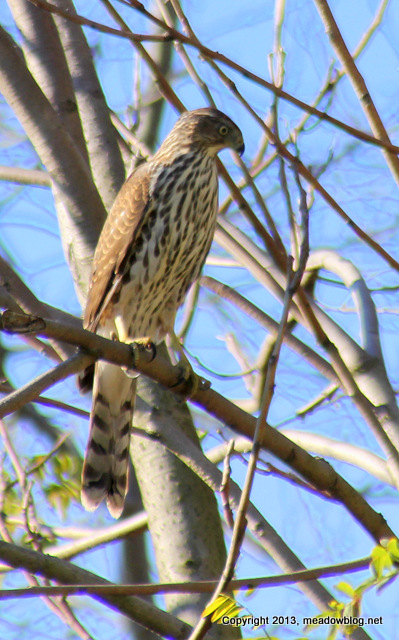 Ah, the age-old question: Is this bird a Sharpie or a Coop — a Sharp-shinned Hawk or a Cooper’s Hawk?
Ah, the age-old question: Is this bird a Sharpie or a Coop — a Sharp-shinned Hawk or a Cooper’s Hawk?
The bird was seen perched briefly near the banding station off Disposal Road late last month.
Seemed like a Sharpie to us. What do you think?
Please leave a comment.

I agree with Sharpie too, based on the thickness of the streaking.
evidence points to a sharpy, check out this awesome comparison page from cornell ornithology for sharp vs. coopers hawk: http://feederwatch.org/learn/tricky-bird-ids/coopers-hawk-and-sharp-shinned-hawk/
This is a juvenile Coopers hawk. A couple of hints is the neat teardrop streaking and the thick legs, a Sharpie has very thin legs.
This is a juvenile Cooper’s hawk. In addition to the characters pointed out by Raymond Gilbert, note the extremely well-graduate tail, the paleness of the nape, and especially the huge bill.
Juvenile Coopers Hawk. The rounded ends of the tail feathers is a dead giveaway.
Looking at the comparison in that link, the bird is away too heavily streaked for a Cooper’s, but the tail is way too rounded for a Sharpie, so which one? This link goes to a juv. Sharpie pic (not mine) that also shows a pale nape. It’s a strange looking specimen 🙂 http://www.hiltonpond.org/images/HawkSharpShinnedMJ04.jpg
juvenile coopers hawk
In addition to the factors noted by others, the general body shape (longer/cylindrical vs. shorter/wedge-shaped) favors juv. Cooper’s id.
Perched juvenile accipitors can be devilish. I try to ignore them unless the Roger Tory Peterson ID point arrows are showing. But here’s an interesting new ID point from Jerry Liguori, the raptor expert. He says on his blog that “Many juvenile Cooper’s Hawks have a pale throat with a stripe down the middle, while many juvenile Sharp-shinneds have a streaked throat.” See the following link for comparison photos:
http://jerryliguori.blogspot.com/search?updated-max=2013-08-29T16:32:00-07:00&max-results=7&start=7&by-date=false
Best,
John
PS: Your bird looks like a Cooper’s, for the reasons others have given, plus the brighter, whiter background on the breast (kid Sharpies are usually “dirty” looking up front, with blotchier markings and less-white background), plus this bird’s head is more angular (Cooper’s sometimes show hackles; Sharp-shinned usu have rounder and smaller-looking heads).
I agree, juvenile Cooper’s.
I tend to agree with the juvenile Sharpie I.D. due to the heavy streaking on both belly and breast and also the flanks.
I think that I also detect a pale superciliary.
I good challenge.
My gut says cooper’s.
It’s definitely a juvenile Coop. One cannot go strictly by color and shape of markings and ignore the other characteristics that define a coop, such as the tubular body, rounded tail, proportionally larger and angular head, and larger feet, legs, and beak.